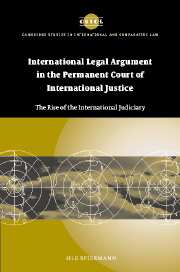 International Legal Argument in the Permanent Court of International Justice
International Legal Argument in the Permanent Court of International Justice Book contents
- Frontmatter
- Contents
- Foreword
- Acknowledgments
- Table of cases
- Table of treaties
- List of abbreviations
- Part 1 The Permanent Court of International Justice
- Part 2 International legal argument
- Part 3 International legal argument in the Permanent Court of International Justice
- 4 Revisiting the Permanent Court
- 5 The foundational period, 1922–1924
- 6 An international lawyer's approach, 1925–1930
- 7 A national lawyer's approach, 1931–1940
- Part 4 General conclusions
- Appendix: List of Advisory Opinions, Judgments and Orders of the Permanent Court of International Justice
- Bibliography
- Index
- CAMBRIDGE STUDIES IN INTERNATIONAL AND COMPARATIVE LAW
6 - An international lawyer's approach, 1925–1930
Published online by Cambridge University Press: 17 July 2009
- Frontmatter
- Contents
- Foreword
- Acknowledgments
- Table of cases
- Table of treaties
- List of abbreviations
- Part 1 The Permanent Court of International Justice
- Part 2 International legal argument
- Part 3 International legal argument in the Permanent Court of International Justice
- 4 Revisiting the Permanent Court
- 5 The foundational period, 1922–1924
- 6 An international lawyer's approach, 1925–1930
- 7 A national lawyer's approach, 1931–1940
- Part 4 General conclusions
- Appendix: List of Advisory Opinions, Judgments and Orders of the Permanent Court of International Justice
- Bibliography
- Index
- CAMBRIDGE STUDIES IN INTERNATIONAL AND COMPARATIVE LAW
Summary
President Huber
At the end of its fifth session, the Permanent Court had to elect a new president. President Loder's rival candidate was Judge Moore, who in a letter to Judge Huber had taken the view that ‘[e]xisting conditions would not be improved by an embittered but unsuccessful effort to make a change in the presidency, which, as you know, Mr Loder strongly desires to retain; and under no circumstances would I consent to the use of my name for a mere demonstration of dissatisfaction’. What Judge Moore had wanted was ‘a substantial majority of my colleagues’. However, repeated voting produced nothing but a series of ties and eventually Judge Moore withdrew his candidacy. A majority of six now favoured the member of the bench who perhaps had exercised the greatest influence on the Permanent Court's work in its foundational period: Judge Huber.
This election was more than a transfer of a title. In 1922, at the Permanent Court's inauguration ceremony, President Loder had said that international law had taken the first step beyond ‘the law of force and of selfishness’. This phrase emphasised the vital role which President Loder and other traditionalists attributed to the project of international justice. It also implied that President Loder considered the conception of the state as a national sovereign, and the national sovereign's interests and ‘selfishness’, that is, the national principle of self-containedness, as the premise from which substantive international law had to develop.
- Type
- Chapter
- Information
- International Legal Argument in the Permanent Court of International JusticeThe Rise of the International Judiciary, pp. 210 - 299Publisher: Cambridge University PressPrint publication year: 2005


